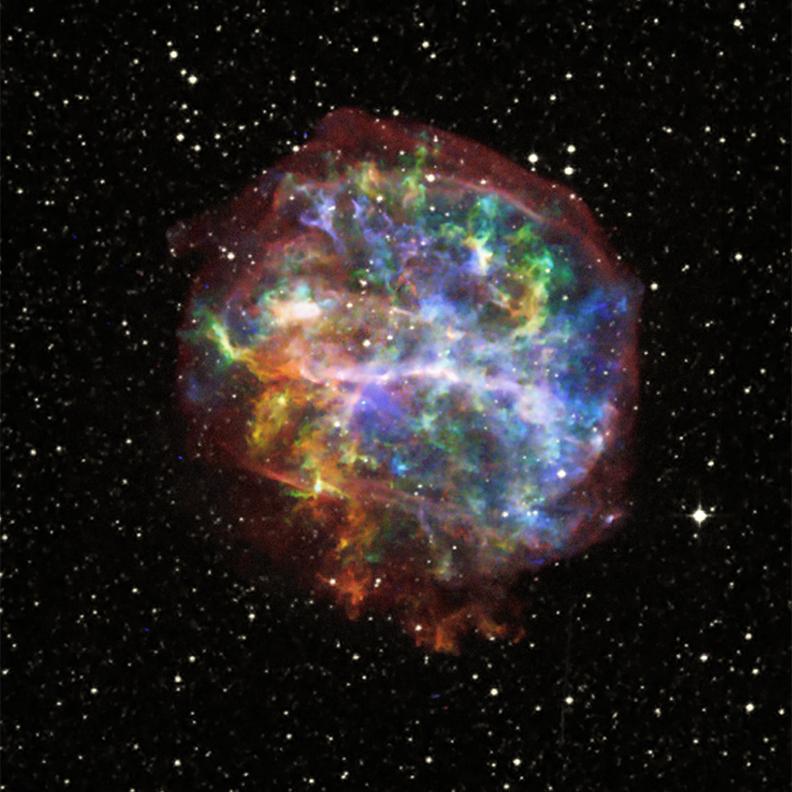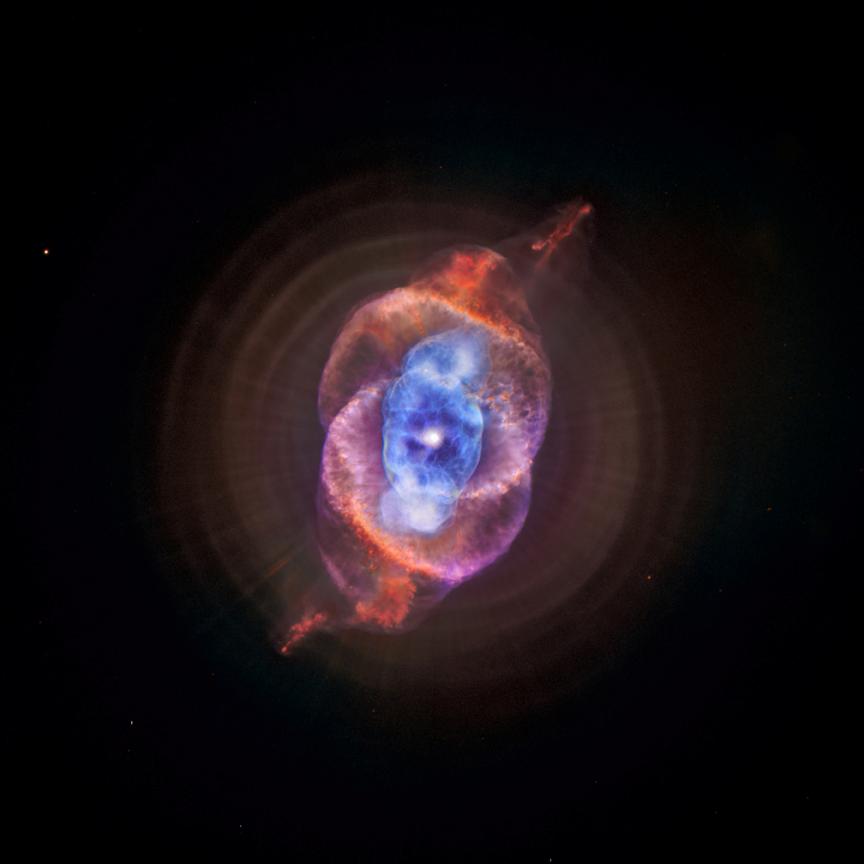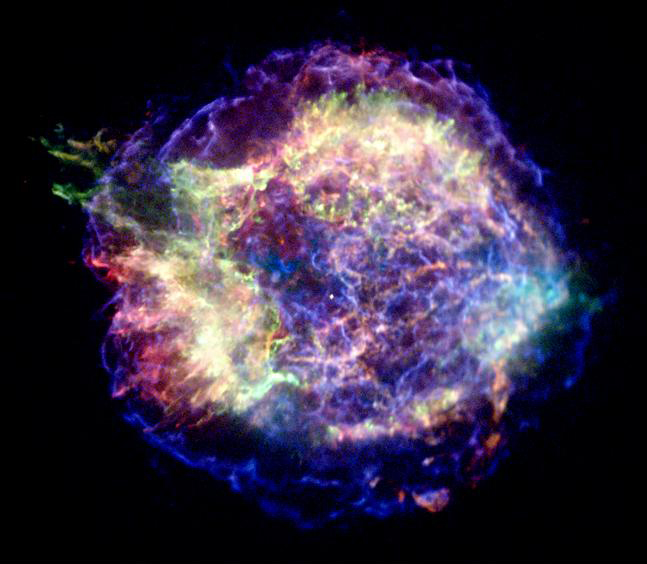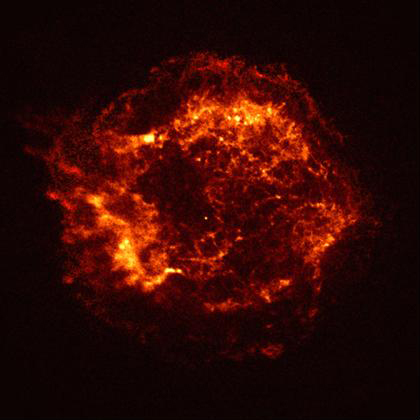CXC Home | Search | Help | Image Use Policy | Latest Images | Privacy | Accessibility | Glossary | Q&A
Type II Supernovae
There are several scenarios that can result in a supernova event; however, supernovas are classified by the type of triggering mechanism that initiates the destruction. Type II supernovas are produced by the core collapse of a massive star – RCW 86 and SN 1987A mentioned above are Type II events. Thermonuclear fusion in stars with masses between ~0.8 and 8 solar masses produces the outward radiation pressure to counterbalance gravitational forces for approximately ten billion years. When the core hydrogen has been converted to helium and fusion stops, gravity takes over and the core begins to collapse. The layers outside the core collapse also - the layers closer to the center collapse more quickly than the ones near the stellar surface. As the layers collapse, the gas compresses and heats up. The core temperature becomes high enough for helium to fuse into carbon and oxygen, with hydrogen to helium fusion continuing in a thin layer surrounding the core. The outer layers expand to an enormous size and the star is now called a red giant. The star brightens by a factor of 1,000 to 10,000, and the surface temperature of the extended envelope drops to about 3,000K - 4,000K, giving the star its reddish appearance. A strong wind begins to blow from the star's surface, carrying away most of the hydrogen envelope surrounding the star's central core. During the final shedding of its envelope, when the mass loss is greatest, the star pulsates - the surface layers expand and then contract in repeating cycles with periods ranging from several months to more than a year. The material ejected by the star forms a planetary nebula which expands into the surrounding interstellar medium at ~17-35 km/s. The core of the star left in the center of the planetary nebula is called a white dwarf. The planetary nebula is very tenuous, and becomes so thin that after ~50,000 years it is no longer visible. A white dwarf can not create internal pressure and its complete collapse is prevented by quantum mechanics. Two electrons with the same "spin" are not allowed to occupy the same energy level. Since there are only two ways an electron can spin, only two electrons can occupy any single energy state; this is called the Pauli Exclusion Principle. In a normal gas, this is not a problem – there are not enough electrons floating around to completely fill up all the energy states. In a white dwarf, all of the electrons are forced close together, and all the energy states in its atoms are filled with electrons. If all the energy states are filled, and it is impossible to put more than two electrons in each state, then the white dwarf has now become degenerate. This means the white dwarf is now degenerate matter; gravity cannot compress it any more because quantum mechanics tells us there is no more available space. The complete collapse of the white dwarf is prevented because it is held in equilibrium with gravity by electron degeneracy pressure. The white dwarf is extremely dense, ~200,000 times more dense than the Earth. The mass limit for a white dwarf to remain in equilibrium between gravity and electron degeneracy pressure is 1.4 solar masses - the Chandrasekhar limit. Over hundreds of billions to a trillion years the white dwarf will radiate its remaining heat away and become a black dwarf - a cold, dark mass of electron degenerate matter.Stars with masses greater than eight solar masses continue nuclear fusion beyond that of core helium. The carbon-oxygen core more massive stars acquired during the core helium fusion contracts and heats. After all of the helium in the core is gone, carbon and oxygen begin to fuse. Their fusion yields neon, magnesium, silicon, and sulfur. Eventually, silicon and sulfur fuse in the star's core to form iron, nickel, and other elements of similar atomic weight. The star's structure now resembles an onion. The central core of the onion consists of iron. Surrounding it is a shell in which silicon and sulfur fuse, adding more iron to the iron core. In additional levels further out, lighter elements fuse - oxygen, carbon, helium, and hydrogen. The iron core is very compact and cannot induce further nuclear fusion. Nuclear fusion is possible only if the reactions release energy. The fusion of iron with other nuclei to make still heavier nuclei requires an input of energy - it is an endothermic nuclear reaction. The energy required to produce elements heavier than iron becomes available only during the imminent catastrophic collapse of the star's core and the violent explosion of the star's outer envelope.
The mass of the star’s iron core approaches 1.4 solar masses due to the continued silicon and sulfur fusion in the thin layer adjacent to the iron core, and the continued fusion of iron requires more energy than is available. Radiation pressure is no longer able to support the core against gravity and the iron core collapses. In less than a second, the core collapses from a diameter of ~8000 kilometers to ~19 kilometers - the collapse happens so rapidly that the outer layers have no time to react or collapse along with the core. The energy released during core collapse is unimaginable - more energy than is produced by 100 stars like the Sun during their entire lifetimes of more than 10 billion years. Most of the energy released during collapse is carried off into space by neutrinos; a small fraction of the energy triggers the accompanying supernova explosion. The core collapses so fast that it momentarily goes past its equilibrium point at nuclear density and instantaneously rebounds. The innermost layers of the star are still in-falling and meet the rebounding core, creating a super strong shock wave that runs outward through the layers towards to the star's surface. The shock wave heats the outer layers, inducing explosive nuclear fusion, and ejects the outermost layers at speeds in excess of ~16 million kilometers per hour. The energy released by the shockwave produces elements heavier than iron. When the shock wave reaches the star's surface, it heats the surface layers and brightens them - within a day or two the exploding star becomes brighter than a billion Suns. The expanding gaseous shell, referred to as a supernova remnant, plows into the surrounding interstellar medium (ISM), and pushes, compresses, and intermingles with it. A forward and a reverse shock are created when the supernova shock wave interacts with the ISM. The forward shock continues to expand into the ISM, and the reverse shock travels back into the freely expanding supernova ejecta - heating the material to millions of degrees Kelvin and producing thermal X-ray emissions. This is a Type II supernova event - the core collapse of a massive star. The end product within the remnant depends upon the initial mass of the star, and is a neutron star, pulsar, magnetar, or black hole.






